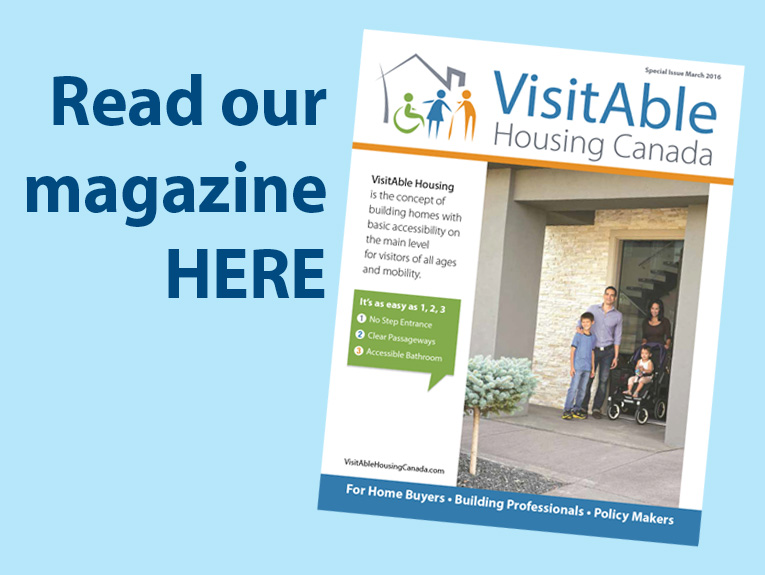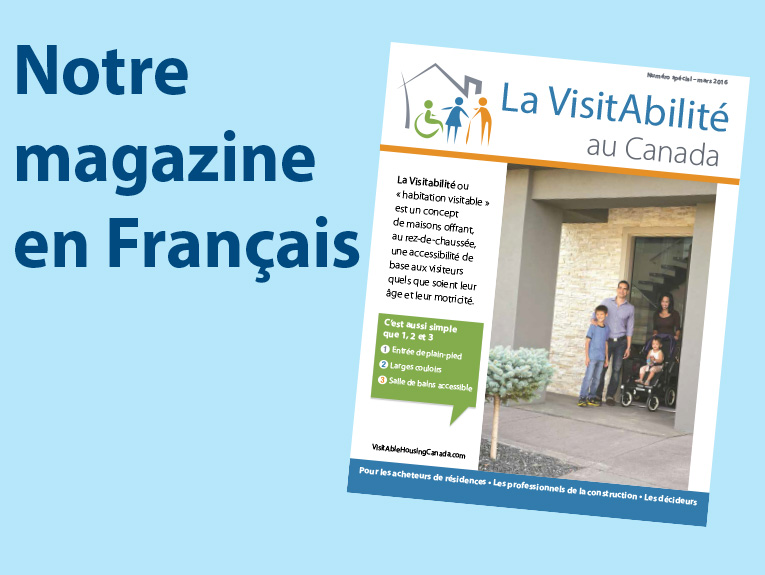Although VisitAble housing is still unfamiliar among many people, the concept is well adopted and applied in a number of regions in North America. Some of exemplary practices of VisitAble housing are introduced here.
Bolingbrook Initiative (1999 – 2003), Bolingbrook, Illinois, USA
Bolingbrook is a town in Illinois, USA, and has a population of roughly 74,000. The village developed the first VisitAbilty code in 1999. Initially, the builders were opposed to these changes. After meeting with Village staff and members of the disability community, along with architects and other design professionals, many of the builders changed their point of view and were on board with the proposed changes. The VisitAbility Code came into law on June 24th, 2003. Currently Bolingbrook has close to 3000 homes that are VisitAble. The number of people that have disabilities and live in Bolingbrook is growing partially due to the number of accessible homes in the community, but also due to the fact that people can stay in their homes should they acquire disabilities. Two new subdivisions are under construction. One is a single family home subdivision and the other is a town-home subdivision in Bolingbrook.
For more information, contact:
Daniel G. Buonamici, Building Commissioner, Village of Bolingbrook
Phone: (630) 226-8470
Email: dbuonami@bolingbrook.com
Bridgwater Project (2006 – 2021), Winnipeg, Manitoba, CANADA
In 2006, the Government of Manitoba, as developer, launched the Bridgwater Project in Winnipeg, Manitoba. The project is a housing development initiative which incorporates VisitAble housing as a key element. It involves a Town Centre and three residential neighbourhoods: Bridgwater Forest, Bridgwater Lakes, and Bridgwater Trails. Bridgwater Forest was the first neighbourhood developed in the project, and the development of Bridgwater Lakes and the Bridgwater Centre has already started. Bridgwater Trails is yet to be developed. The project will include over 1,000 VisitAble houses and hundreds of multi-family units with VisitAbility features. In Bridgwater Forest and Bridgwater Lakes, over 200 VisitAble houses have already been built and are occupied. The Bridgwater neighbourhoods is currently the fastest selling subdivision in Winnipeg.
For more information, contact:
Dwayne Rewniak, Director, Land Development
Manitoba Housing and Renewal Corporation, Manitoba Government
Phone: (204) 945-4703
Email: Dwayne.rewniak@mb.gov.ca
Prince George VisitAble Housing Project (2009 – 2011), Prince George, British Columbia, CANADA
The City of Prince George set up a VisitAble Housing Project with the objective of compiling a comprehensive information package to assist the City in developing policies, guidelines or mandatory regulations to promote VisitAble housing for new single-or semi-detached homes. The project identified a number of best practices. In March 2011, the City approved the recommendations for voluntary guidelines and mandatory regulations. This includes preparing objectives and policies for VisitAble housing within the Official Community Plan review that: identifies the creation of VisitAble housing as a community objective; contemplates further analysis of VisitAble housing within an amenity contribution policy and incentives packages; provides direction to consider the VisitAble Housing Voluntary Design Guidelines as part of the development review process; and requires that, on land sold by the City of Prince George, no less than 15% of newly constructed market-rate single and semi-detached homes be VisitAble and all newly constructed affordable (non-market) single and semi-detached homes be VisitAble.
For more information, contact:
Tiina Watt, Supervisor, Long Range Planning
The City of Prince George
Phone: (250) 561-7731
Email: kwatt@city.pg.bc.ca
Measuring Up the North (), Northern British Columbia Communities, CANADA
The Project used a community participatory action and community development approach to empower and build community capacity. The principles of the Project included local control by local partners, universal design, facilitation and support of planning accessibility and inclusion throughout the Project, bringing together the right people and ensuring the dignity, respect and inclusion of all partners within an intergenerational approach. It was anticipated there would be increased participation and inclusion of persons with disabilities and older adults in all aspects of the community. Successes ranged from numerous northern communities building VisitAble environments with housing, businesses, child care centres, and recreational sites.
For more information, contact:
Laurie Ringaert
Email: lringaert@gmail.com
Website: http://measureupthenorth.com
Flex-Plex Housing Affordability Project (2001 – 2010), Saanich, British Columbia, CANADA
The intent of the project was to create accessible, affordable housing and the first legal suites in Saanich in a project that could be replicated in the region. This project was built to be accessible to persons with limited mobility. Four of the five units would qualify as VisitAble Housing. The Victoria Home Builders Association initiated the project, secured the land, hired the designers, etc. They handed it off to Habitat for Humanity to build the project.
For more information, contact:
Wayne Davis Canadian Home Builders Association – Victoria
Email: waynedavis@shaw.ca



